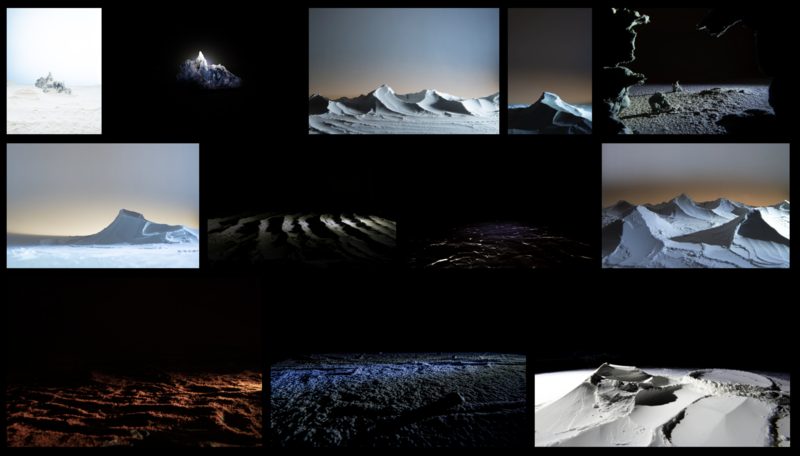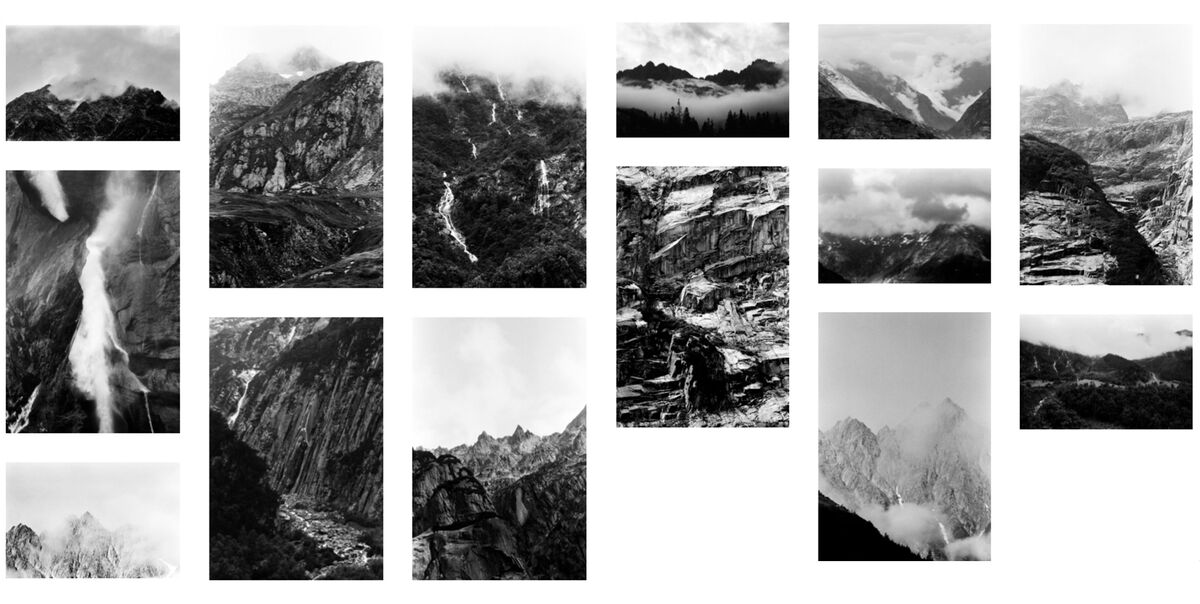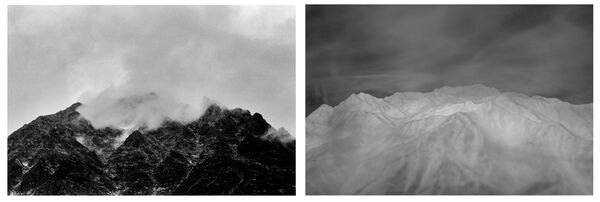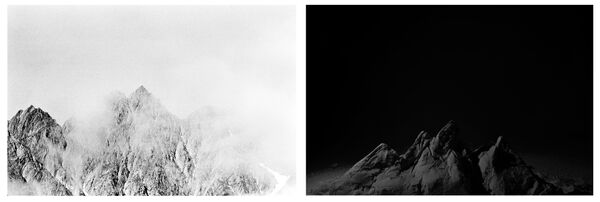Sacha-project proposal: Difference between revisions
Sacha Dufils (talk | contribs) No edit summary |
Sacha Dufils (talk | contribs) |
||
| (84 intermediate revisions by 2 users not shown) | |||
| Line 1: | Line 1: | ||
===What and How are you going to make it?=== | |||
During the pandemic of 2020, I started working in the studio to make self-constructed landscapes. I wanted to escape the reality I inhabited. Missing the possibility to go places, at first I wanted to make landscapes that look like Earth. When I was forced to cancel my trip to the Alps I started to built my own snowy mountains. Later I became interested in traveling even further and became inspired by distant expeditions and images from other planets. I started to incorporate the alien aspect in these self-constructed landscapes. Some of the images evoke uncanniness that speaks of alien landscapes, dreams of the ‘otherworldly’ and science fiction cinema. | During the pandemic of 2020, I started working in the studio to make self-constructed landscapes. I wanted to escape the reality I inhabited. Missing the possibility to go places, at first I wanted to make landscapes that look like Earth. When I was forced to cancel my trip to the Alps I started to built my own snowy mountains. Later I became interested in traveling even further and became inspired by distant expeditions and images from other planets. I started to incorporate the alien aspect in these self-constructed landscapes. Some of the images evoke uncanniness that speaks of alien landscapes, dreams of the ‘otherworldly’ and science fiction cinema. | ||
Through my miniaturisation of landscape photography, I have been able to focus on photography as image making rather than recording. I developed interesting methods within this project to explore themes of escapism and traveling within strict limitations. The works deceives the viewer, creating a sublime landscape from otherwise prosaic materials. This way I want to challenge the notion of the imagined sublime and our willingness to believe in it. | Through my miniaturisation of landscape photography, I have been able to focus on photography as image making rather than recording. Instead of capturing an image, I created an image from scratch by building a landscape myself. This gives a lot of control in the image-making. I developed interesting methods within this project to explore themes of escapism and traveling within strict limitations. The works deceives the viewer, creating a sublime landscape from otherwise prosaic materials. This way I want to challenge the notion of the imagined sublime and our willingness to believe in it. | ||
I want to make a body of work wherein the experience of landscape | |||
[[File:Schermafbeelding 2021-11-08 om 21.12.22.png|800px]] | |||
In 2021, the borders were opened again and I started traveling. I made a series of photographs of real mountains in Switzerland. This year, I want to make a body of work wherein the experience of landscape takes a central place. This includes finishing the current project I am working on. Going through the 90 images I made of the Swiss mountains and make a selection out of these images that I want to turn into a presentation. The possible outcomes are numerous, including a book, or an installation consisting of projections, or another form. Part of the research will be into finding an appropriate vehicle for the material I am producing. | |||
[[File:Tobeamountain.jpg|1200px]] | |||
While photographing outside again, I've noticed that my gaze had changed. Whereas I normally pack a lot of materials and equipment, I now made this series with one camera and lens. I didn’t take ‘props’ but only focused on the mountains themselves. I was more focused on getting close instead of capturing the vastness of the landscape. The textures and tactile-ness in this work made me want to create mountains out of other materials myself again. I'm going to build landscapes out of natural materials but also very human-made materials such as 3D prints. Proposed outcomes: a series of diptychs comprising simulated and 'real' landscapes. I want to find out what it means when you construct a landscape. | |||
I plan to travel to different places and produce landscape images and then respond to those images with a constructed iteration. I want to maintain a flexible approach to these experiments and produce a number of outcomes. In wintertime I’m going back to the mountains to make new work and here I want to also continue the experiments of moving images I began last year. | |||
[[File:Diptych 1.jpg|600px]] [[File:Diptych 2.jpg|600px]] | |||
===Why do you want to make it?=== | |||
I am fascinated about how we live in and are influenced by our environment and how we can use our imagination to create a new one. The power of nature dominates us, but I have dominion over the constructed landscape that fits in my hand. This power dynamic between humans and nature is something I'm going to explore more in my upcoming projects. Due to the contrast of the grand and the small, it is important that I also experiment with scale in the final presentation. For a long time, I wanted my work not only to be about my own experience but also about making this experience accessible for the spectator. So one of the important things to focus on this year would be to create an immersive experience for the spectator. Therefore, I’d like to experiment to present with different materials. This includes different kind of papers to deepen the texture aspect. But possibly also work with (slide) projections, light(panels), video installations, stereo viewers, spaces and soundscapes. | |||
===Who can help you and how?=== | |||
My tutors will help me this year by continuing the conversation about my work and reflecting on it. Also, we have the opportunity to invite a guest ‘mentor’. An artist who's work involves the landscape in a very imaginary way is Bethany de Forest. She makes huge diorama's which she photographs. She also has experience in filmmaking and stereo-photography. I'd be also very much interested in talking to installation artists or even set designers, since they often create immersive surroundings in their art. I’d like to investigate a bit more who I want to invite. Other than that, I'm taking workshops in the wood station and ceramics station to see how I can build things myself. I can also use these skills to put together an installation. | |||
===Relation to previous practice=== | |||
The landscape is a central subject in my work. I am taking on different approaches within this subject and I try to deepen this more. Instead of using the landscape just as a ‘decor’ for my work, as I did before, I am now approaching it as a self-contained being. In my research I'm also looking at different views (anthropological, ethnographic, geological, geographical, cultural, environmental, aesthetic). | |||
===Relation to a larger context=== | |||
There’s a relationship with my work with the following themes: Romanticism, The Sublime experience, Escapism, the Anthropocene. | |||
===Timetable=== | |||
' | Form November until December I will work on my constructed landscapes and continue to work on the diptychs. In December I'm traveling to the mountains again and making a new series of work. I'll be selecting the images I made from this trip in the months January and February. From this period I'll be also making constructed iterations on the work. | ||
===References/bibliography=== | |||
Conversations with landscape – Karl Benediktsson, Katrin Anna Lund | Conversations with landscape – Karl Benediktsson, Katrin Anna Lund | ||
''Conversations With Landscape moves beyond the conventional dualisms associated with landscape, exploring notions of landscape and its relation with humans through the metaphor of conversation. With contributions drawn from a variety of disciplines, including anthropology, geography, archaeology, philosophy, literature and the visual arts, this book explores the affects and emotions engendered in the conversations between landscape and humans.'' | |||
Examples: the making of 40 photographs - Ansel Adams | Examples: the making of 40 photographs - Ansel Adams | ||
''Ansel Adams talks about the situations around the making of his photos and the methods he used to realize them. Each image is accompanied by a text that studies the technical and aesthetic conditions of the subject and contains memories of the places and people involved.'' | |||
Space is the place – Lukas Feireiss | Space is the place – Lukas Feireiss | ||
''Together with artists, designers, architects, curators, historians, theoreticians and philosophers, it questions the experience, imagination and design of spaces and places in theory and practice. The publication looks at contemporary artistic practices that turn spaces into places. Space and place are explored as topics and mediums of playful investigation and serious reflection. | |||
'' | |||
Landscape and power – W.J.T. Mitchell | |||
''A studie on landscape by considering landscape not simply as an object to be seen or a text to be read, but as an instrument of cultural force, a central tool in the creation of national and social identities'' | |||
The Living Mountain - Nan Shepherd | |||
''Nan Shepherd describes her journeys into the Cairngorm mountains of Scotland. There she encounters a world that can be breathtakingly beautiful at times and shockingly harsh at others. Shepherd spent a lifetime in search of the 'essential nature' of the Cairngorms.'' | |||
Mountains Of The Mind - Robert Mcfarlane | |||
''In Macfarlane's Mountains of the Mind, he sets out to explain what drives people to the mountains in their droves, and especially what drives those who are prepared to risk their lives in pursuit of a particular summit.'' | |||
Natural:Mind - Vilém Flusser | |||
''Flusser investigates the paradoxical connection between the concepts of nature and culture through a para-phenomenological analysis of natural and cultural phenomena.'' | |||
Henri Lefèbvre - The production of space | |||
''The book is a search for a reconciliation between mental space and real space. In the course of his exploration, Lefèbvre moves from metaphysical and ideological considerations of the meaning of space to its experience in the everyday life of home and city.'' | |||
===Technical plan outline=== | |||
''Needs'' | |||
Tools I'm going to use are: slide film, slide projectors, digital projectors, photo-printing, 3D printing, (film) camera's, editing software, (clay) sculpting, mold making. | |||
''How'' | |||
I'm going to use these techniques to create my constructed landscapes and also to present my final work. | |||
''Challenges'' | |||
I possess good skills in analog photography, so working with slide film and projectors shouldn't be problematic. I have little skills in 3D printing but I have help in that area. As for sculpting and making molds I'm going to work in the ceramics workshop in school and ask for assistance there. I don't foresee big threats, since all of these challenges aren't very big. | |||
''Timepath'' | |||
I need these skills in the upcoming weeks (months). I already did an introduction to the ceramics workshop and 'm going to work there in the following weeks. As for 3D printing I'll work closely with someone that has the skills to help me out. This will also be in the upcoming weeks. | |||
''Strategy'' | |||
I have little skills in 3D printing but I have help in that area. As for sculpting and making molds I'm going to work in the ceramics workshop in school and ask for assistance there. | |||
''Peers with same interest'' | |||
There are several peers in LB2 that are skilled in filming. So I will ask them for advice regarding equipment. | |||
''Tools not to use and why'' | |||
I could make a step into 3D modeling software, this could be a good way of creating my ideas in. But I don't see myself developing the skills in this since I have little affinity with it. | |||
Latest revision as of 22:45, 8 December 2021
What and How are you going to make it?
During the pandemic of 2020, I started working in the studio to make self-constructed landscapes. I wanted to escape the reality I inhabited. Missing the possibility to go places, at first I wanted to make landscapes that look like Earth. When I was forced to cancel my trip to the Alps I started to built my own snowy mountains. Later I became interested in traveling even further and became inspired by distant expeditions and images from other planets. I started to incorporate the alien aspect in these self-constructed landscapes. Some of the images evoke uncanniness that speaks of alien landscapes, dreams of the ‘otherworldly’ and science fiction cinema.
Through my miniaturisation of landscape photography, I have been able to focus on photography as image making rather than recording. Instead of capturing an image, I created an image from scratch by building a landscape myself. This gives a lot of control in the image-making. I developed interesting methods within this project to explore themes of escapism and traveling within strict limitations. The works deceives the viewer, creating a sublime landscape from otherwise prosaic materials. This way I want to challenge the notion of the imagined sublime and our willingness to believe in it.
In 2021, the borders were opened again and I started traveling. I made a series of photographs of real mountains in Switzerland. This year, I want to make a body of work wherein the experience of landscape takes a central place. This includes finishing the current project I am working on. Going through the 90 images I made of the Swiss mountains and make a selection out of these images that I want to turn into a presentation. The possible outcomes are numerous, including a book, or an installation consisting of projections, or another form. Part of the research will be into finding an appropriate vehicle for the material I am producing.
While photographing outside again, I've noticed that my gaze had changed. Whereas I normally pack a lot of materials and equipment, I now made this series with one camera and lens. I didn’t take ‘props’ but only focused on the mountains themselves. I was more focused on getting close instead of capturing the vastness of the landscape. The textures and tactile-ness in this work made me want to create mountains out of other materials myself again. I'm going to build landscapes out of natural materials but also very human-made materials such as 3D prints. Proposed outcomes: a series of diptychs comprising simulated and 'real' landscapes. I want to find out what it means when you construct a landscape.
I plan to travel to different places and produce landscape images and then respond to those images with a constructed iteration. I want to maintain a flexible approach to these experiments and produce a number of outcomes. In wintertime I’m going back to the mountains to make new work and here I want to also continue the experiments of moving images I began last year.
Why do you want to make it?
I am fascinated about how we live in and are influenced by our environment and how we can use our imagination to create a new one. The power of nature dominates us, but I have dominion over the constructed landscape that fits in my hand. This power dynamic between humans and nature is something I'm going to explore more in my upcoming projects. Due to the contrast of the grand and the small, it is important that I also experiment with scale in the final presentation. For a long time, I wanted my work not only to be about my own experience but also about making this experience accessible for the spectator. So one of the important things to focus on this year would be to create an immersive experience for the spectator. Therefore, I’d like to experiment to present with different materials. This includes different kind of papers to deepen the texture aspect. But possibly also work with (slide) projections, light(panels), video installations, stereo viewers, spaces and soundscapes.
Who can help you and how?
My tutors will help me this year by continuing the conversation about my work and reflecting on it. Also, we have the opportunity to invite a guest ‘mentor’. An artist who's work involves the landscape in a very imaginary way is Bethany de Forest. She makes huge diorama's which she photographs. She also has experience in filmmaking and stereo-photography. I'd be also very much interested in talking to installation artists or even set designers, since they often create immersive surroundings in their art. I’d like to investigate a bit more who I want to invite. Other than that, I'm taking workshops in the wood station and ceramics station to see how I can build things myself. I can also use these skills to put together an installation.
Relation to previous practice
The landscape is a central subject in my work. I am taking on different approaches within this subject and I try to deepen this more. Instead of using the landscape just as a ‘decor’ for my work, as I did before, I am now approaching it as a self-contained being. In my research I'm also looking at different views (anthropological, ethnographic, geological, geographical, cultural, environmental, aesthetic).
Relation to a larger context
There’s a relationship with my work with the following themes: Romanticism, The Sublime experience, Escapism, the Anthropocene.
Timetable
Form November until December I will work on my constructed landscapes and continue to work on the diptychs. In December I'm traveling to the mountains again and making a new series of work. I'll be selecting the images I made from this trip in the months January and February. From this period I'll be also making constructed iterations on the work.
References/bibliography
Conversations with landscape – Karl Benediktsson, Katrin Anna Lund
Conversations With Landscape moves beyond the conventional dualisms associated with landscape, exploring notions of landscape and its relation with humans through the metaphor of conversation. With contributions drawn from a variety of disciplines, including anthropology, geography, archaeology, philosophy, literature and the visual arts, this book explores the affects and emotions engendered in the conversations between landscape and humans.
Examples: the making of 40 photographs - Ansel Adams
Ansel Adams talks about the situations around the making of his photos and the methods he used to realize them. Each image is accompanied by a text that studies the technical and aesthetic conditions of the subject and contains memories of the places and people involved.
Space is the place – Lukas Feireiss
Together with artists, designers, architects, curators, historians, theoreticians and philosophers, it questions the experience, imagination and design of spaces and places in theory and practice. The publication looks at contemporary artistic practices that turn spaces into places. Space and place are explored as topics and mediums of playful investigation and serious reflection.
Landscape and power – W.J.T. Mitchell
A studie on landscape by considering landscape not simply as an object to be seen or a text to be read, but as an instrument of cultural force, a central tool in the creation of national and social identities
The Living Mountain - Nan Shepherd
Nan Shepherd describes her journeys into the Cairngorm mountains of Scotland. There she encounters a world that can be breathtakingly beautiful at times and shockingly harsh at others. Shepherd spent a lifetime in search of the 'essential nature' of the Cairngorms.
Mountains Of The Mind - Robert Mcfarlane
In Macfarlane's Mountains of the Mind, he sets out to explain what drives people to the mountains in their droves, and especially what drives those who are prepared to risk their lives in pursuit of a particular summit.
Natural:Mind - Vilém Flusser
Flusser investigates the paradoxical connection between the concepts of nature and culture through a para-phenomenological analysis of natural and cultural phenomena.
Henri Lefèbvre - The production of space
The book is a search for a reconciliation between mental space and real space. In the course of his exploration, Lefèbvre moves from metaphysical and ideological considerations of the meaning of space to its experience in the everyday life of home and city.
Technical plan outline
Needs Tools I'm going to use are: slide film, slide projectors, digital projectors, photo-printing, 3D printing, (film) camera's, editing software, (clay) sculpting, mold making.
How I'm going to use these techniques to create my constructed landscapes and also to present my final work.
Challenges I possess good skills in analog photography, so working with slide film and projectors shouldn't be problematic. I have little skills in 3D printing but I have help in that area. As for sculpting and making molds I'm going to work in the ceramics workshop in school and ask for assistance there. I don't foresee big threats, since all of these challenges aren't very big.
Timepath I need these skills in the upcoming weeks (months). I already did an introduction to the ceramics workshop and 'm going to work there in the following weeks. As for 3D printing I'll work closely with someone that has the skills to help me out. This will also be in the upcoming weeks.
Strategy I have little skills in 3D printing but I have help in that area. As for sculpting and making molds I'm going to work in the ceramics workshop in school and ask for assistance there.
Peers with same interest There are several peers in LB2 that are skilled in filming. So I will ask them for advice regarding equipment.
Tools not to use and why I could make a step into 3D modeling software, this could be a good way of creating my ideas in. But I don't see myself developing the skills in this since I have little affinity with it.




